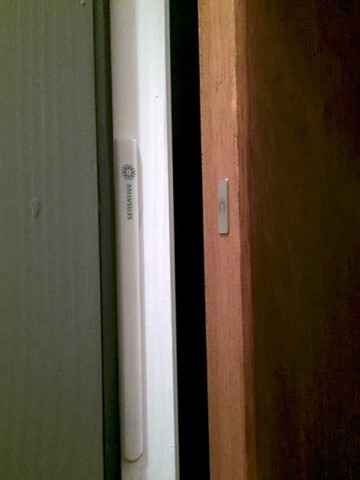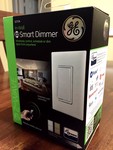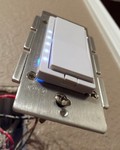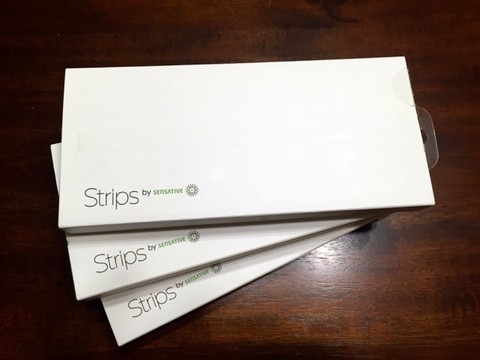
Sensative Strips are thin devices that you can install on a door or window to detect the open or closed state. They’re small, they’re functional, and amazingly enough, they speak Z-Wave. Install one on the frame of your door, and you have a nice little sensor without having to run wires.
I got mine from a seller on Amazon.
They’re also fiddly little things, at least when pairing with OpenHAB…
What’s In The Box
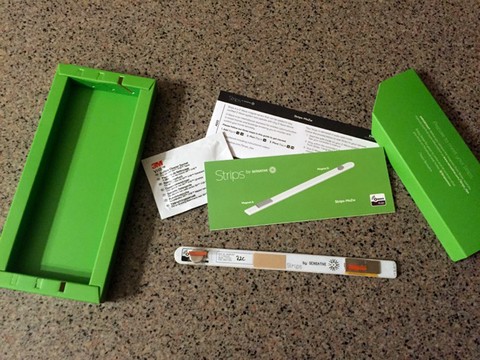 The Strips come in a small, flat box, and there’s not
much in it. You’ll receive one Strips sensor with two magnets taped to
it; a card with pictorial instructions; a packaged 3M cleaning wipe; a
sheet of paper with textual instructions, and… that’s it. It’s
fairly well packaged, and I’m surprised they don’t turn up in the
local Best Buy next to Philips Hue.
The Strips come in a small, flat box, and there’s not
much in it. You’ll receive one Strips sensor with two magnets taped to
it; a card with pictorial instructions; a packaged 3M cleaning wipe; a
sheet of paper with textual instructions, and… that’s it. It’s
fairly well packaged, and I’m surprised they don’t turn up in the
local Best Buy next to Philips Hue.
Unfortunately, the documentation leaves a bit to be desired. It isn’t as clear as it could be on where the magnets need to be to trigger the Strip. Hint: remember where the magnets were taped to it, as that’s where they will trigger things. The rectangular magnet goes on the door so it can tell when the door is closed, and the round one can be swiped over the Strips in order to perform various functions.
Do NOT remove the magnets before you’re ready to include the sensor into your network! While it will work if you do, I found that it was a bit faster if you don’t.
Connecting to OpenHAB
I don’t know how well they work with other controllers, but if you’re going to use these with OpenHAB, make sure you’re in a patient mood. They’re fiddly, and the method is non-obvious. Fortunately, you’ll only have to do this once per Strips.
I hope.
In any event, the procedure goes something like this:
- Put your OpenHAB Z-Wave binding into discovery mode.
- Remove the magnets from the Strips (or trigger a wakeup if you’ve done so already), which will cause it to immediately join the network.
- Add the resulting Thing in OpenHAB.
- Create the necessary items if you’re not in Simple Linking mode (see next section).
At this point, you’d think you’d be done, right? In reality, though, you’ll be lucky if you manage to get that last step to work. The Strips sensors simply don’t stay awake long enough for OpenHAB to configure them in one shot, which results in partial initialization.
To fix it, do this:
- Wake up the Strips sensor. This is accomplished by holding the round magnet over the rounded end of the strip until the light blinks. Then move the magnet away and do it again, for a total of three blinks.
- Wake up the Strips sensor.
- Wake up the Strips sensor.
- Wake up the Strips sensor…
Annoyingly, you have to keep waking the thing up until OpenHAB finally gets it into a state where it’s usable. If there’s one downside to this product, this is it. It’s extremely annoying! And to make matters worse, you’re not done yet!
Oh, and don’t forget to go back and add your items if you failed before…
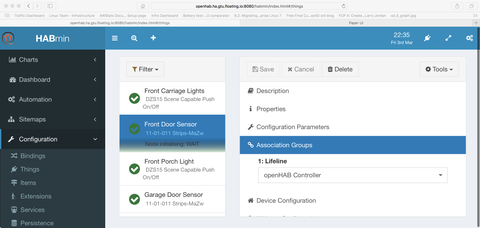 Once the Strips can be seen by OpenHAB, you need to set the
Association Group for the sensor to point at your Z-Wave
controller. This will allow the Strips to send you notifications when
things happen. I recommend using HABmin for this; the Paper UI doesn’t
give you any choices, and what you should enter is non-obvious. HABmin
will give you a drop down (in Configuration/Things, select your
sensor, then go to the Association Group section), which you should
set to “openHAB Controller” (Note that this is NOT the same thing you
would enter into the Paper UI!). Now click Save.
Once the Strips can be seen by OpenHAB, you need to set the
Association Group for the sensor to point at your Z-Wave
controller. This will allow the Strips to send you notifications when
things happen. I recommend using HABmin for this; the Paper UI doesn’t
give you any choices, and what you should enter is non-obvious. HABmin
will give you a drop down (in Configuration/Things, select your
sensor, then go to the Association Group section), which you should
set to “openHAB Controller” (Note that this is NOT the same thing you
would enter into the Paper UI!). Now click Save.
And now you need to wake the sensor up a bunch of times until OpenHAB manages to get the association group set.
And finally, you’re done.
Once you have your Strips recognized, the items added, and the association group set, you should be able to see changes in the sensor if you remove or replace the door magnet at the flat end.
OpenHAB Items
The sensor provides three channels: one for whether the door is open or closed, one for tamper alerts, and one for battery level. If you’re using files, you can configure the first as Contact item, the second as a Switch, and the third as a Number, like this:
Contact my_door "Door Sensor" { channel="zwave:device:########:node#:sensor_door" }
Switch my_door_tamper "Door Sensor Tamper Alarm" { channel="zwave:device:########:node#:alarm_tamper" }
Number my_door_battery "Door Sensor Battery Level" { channel="zwave:device:########:node#:battery-level" }
You should, of course, replace the # characters with the appropriate information from your installation (or just grab the entire channel string from the Thing page in the Paper UI).
The Door Sensor works as expected: it will be either OPEN or CLOSED. When the Strips detects the door opening or closing, this item will be updated. Easy peasy.
The battery is a percentage of charge, represented as a number from 0-100. I assume that if you hit 0, it’s time to replace your Strips; the batteries in them are not user serviceable. Several people have posted online that it’s still at 100% after a year of operation; YMMV.
Writing Rules
Writing a rule for the open/closed state is exactly as one would expect. For example, I’m playing with the following rule for my front door sensor:
rule "Ingress Lights On"
when
Item sensor_front_door changed from CLOSED to OPEN
then
if (gLivingRoom.state == OFF && light_porch_front.state == ON && light_office.state == 0) {
logInfo("auto-lights", "AUTOLIGHT: Front door triggered automatic entry illumination.");
sendCommand(gLivingRoom, ON);
} else {
logInfo("auto-lights", "AUTOLIGHT: At least some lights are already on; ignoring front door.");
}
end
As you can see, you can simply watch for changes in the sensor from CLOSED to OPEN, or vice versa. OpenHAB does exactly what you expect, and it seems pretty reliable. There will be a short delay before it triggers – the sensor takes a second to transmit the state change notification – but that’s all.
I haven’t managed to get the tamper alarm to work yet. It’s probably because I’m new to OpenHAB, but who knows; I’ll update this post if I ever figure it out…
Mounting Your Strips
- Find a spot where the Strips will fit between your door and the frame. This can be on any edge of the door. Make sure you have enough room, or your door won’t close – or you’ll squish your Strips.
- Peel the brown backing from the small temporary adhesive on the back of the Strips and apply it to the frame in appropriate spot.
- Position your magnet on the door such that it will hover over the Strips when it closes. Note that the magnet does NOT have temporary adhesive. I used a little roll of scotch tape on the back of the magnet when I test-positioned mine.
- Close and open the door a few times, and make sure that OpenHAB gets the notifications reliably.
- If it doesn’t work, reposition the sensor and/or magnet and try again.
- Mark the position of the strips and the magnet.
- Use the included 3M wipe to clean the surfaces where you’ll mount the strips and magnet.
- Peel the backing off the magnet and stick it to the door in the marked position.
- Do the same with the Strips, attaching it to the door frame in the marked position.
Simple enough.
Strips won’t work on every door you have. I have several that are too snug in the frame to allow a Strips and associated magnet to exist between the door and the frame. Also, the Strips documentation says that it won’t work on metal surfaces because they’ll interfere with the magnet and reduce the power of the Z-Wave signal.
In my case, I mounted one at the top of my garage entry door, and on the hinge side of my front door. I wonder if the house shifting will cause problems on the latter as it’s a tight fit, but only time will tell.
Final Thoughts
For basic entry notification, Sensative Strips present a very effective solution. The installation with OpenHAB sucks, but once they’re installed, they work just fine – though I recommend configuring persistence, or you won’t have good data after you restart the server, at least until the thing wakes up (once daily by default). I plan to use these to trigger simple automations like turning the lights on when I open the door.
If you’re planning on using them as part of a security setup, caveat emptor. I’m of the opinion that wired sensors are the only way to go if you want a robust and reliable security system. Many folks are likely to disagree with me, but there you go.
Probably the biggest downside is that they aren’t quite as thin as I hoped, which means they won’t work on a lot of my doors. The documentation suggests that there’s an alternative way to mount them, but what that way is, is very unclear. As I said above, the documentation leaves something to be desired.
Will I buy more of these? Yes. They’re dead useful. Hopefully the OpenHAB folk will find a way to make them easier to install at some point.
